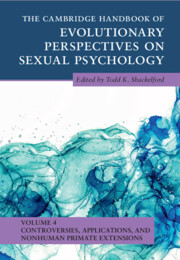Book contents
- The Cambridge Handbook of Evolutionary Perspectives on Sexual Psychology
- The Cambridge Handbook of Evolutionary Perspectives on Sexual Psychology
- Copyright page
- Contents
- Contributors
- Preface
- Part I Controversies and Unresolved Issues
- Part II Applications to Health, Law, and Pornography
- Part III Nonhuman Primate Sexual Behavior
- 14 Chimpanzee Sexual Behavior
- 15 Bonobo Sexual Behavior and Psychology
- 16 Orangutan Sexual Behavior
- 17 Gibbon Evolved Sexual Psychology
- 18 Sexual Behavior in Marmosets in the Context of Cooperative Breeding
- 19 Capuchin Sexual Behavior
- 20 Sexual Behavior in Neanderthals
- Index
- References
15 - Bonobo Sexual Behavior and Psychology
from Part III - Nonhuman Primate Sexual Behavior
Published online by Cambridge University Press: 30 June 2022
- The Cambridge Handbook of Evolutionary Perspectives on Sexual Psychology
- The Cambridge Handbook of Evolutionary Perspectives on Sexual Psychology
- Copyright page
- Contents
- Contributors
- Preface
- Part I Controversies and Unresolved Issues
- Part II Applications to Health, Law, and Pornography
- Part III Nonhuman Primate Sexual Behavior
- 14 Chimpanzee Sexual Behavior
- 15 Bonobo Sexual Behavior and Psychology
- 16 Orangutan Sexual Behavior
- 17 Gibbon Evolved Sexual Psychology
- 18 Sexual Behavior in Marmosets in the Context of Cooperative Breeding
- 19 Capuchin Sexual Behavior
- 20 Sexual Behavior in Neanderthals
- Index
- References
Summary
Deep within the Salonga National Park, Democratic Republic of Congo, a shrill chorus of hooting suddenly erupts through the rainforest; a party of wild bonobos from the Bompusa community has just discovered a large fruit tree full of ripe fruits! As the bonobos rapidly start to climb up tree trunks into the canopy, their excited calls echo through the forest; “a food tree has been found!” Other community members quietly foraging and resting nearby, stop what they are doing, look up and start to rush towards the tree to join the other community members there. Among those joining the tree is Wilma, an adult female who joined the Bompusa community five years ago, as a young immigrant. When she emigrated from her natal group, during an intergroup encounter, Wilma was still a pre-pubescent female who was only beginning to exhibit a genital swelling. Now, Wilma is fully integrated into the community and in her sexual prime. Today, she displays a huge genital swelling in full tumescence, with a bright pink color and a gleaming sheen that advertises her receptivity. As Wilma reaches the canopy, she is greeted there by Camillo – the dominant male. Camillo is the adult son of Martha, one of the oldest alpha females in the community. The scene unfolds. Camillo moves over the branches, arching his back while presenting his erect penis to Wilma. Reaching for balance, Camillo grasps onto a branch while performing his sexual invitation. Wilma responds by quickly crouching and turning to direct her swelling towards him; as the pair copulate, Wilma emits loud copulation screams that are audible to anyone in the feeding tree. Afterwards, as Camillo returns to feeding, another bonobo approaches Wilma – this time it is Camillo’s mother, Martha; older and slower now, but still dominant and respected in the group. Martha leans back, widens her legs and beckons Wilma towards her in a typical solicitation for sexual interactions between females. But this time Wilma stays put – invitation refused. Martha tries again; this time, while holding onto the branch, she picks up her foot and gestures towards her own swelling to make her intentions clear. Despite her high status, her invitation is again refused. Not deterred, Martha tries again; leaning back now, pouting her lips into a duck face and giving a faint infantile whimper as she starts to get frustrated. With Wilma continuing to ignore her requests, the usually unflappable Martha loses all composure – her social expectations violated by this refusal by Wilma. She bares her teeth and starts to scream, she shakes branches and starts to run about. Now in a full temper tantrum, Martha suddenly descends the tree, screaming and voluntarily falling down into the undergrowth in her shock over this sexual rejection. The group is silenced by Martha’s outburst. Camillo and Wilma quietly look on, while continuing to feed on their fruits.
- Type
- Chapter
- Information
- Publisher: Cambridge University PressPrint publication year: 2022
References
- 1
- Cited by



